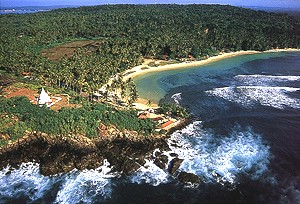

The beauty of Unawatuna bay a few miles east of Galle in southern Lanka is world famous. Over 20 years ago, the beach was clean with no tourist hotels to spoil its scenic beauty.
That is the Unawatuna I remember from my childhood when each year in July I would go with my parents for a festival of lights in the Devale located at the tip of the bay. Each day of the week-long celebration was allocated to one dayaka of that ancient place of worship.
The Devale although primarily Hindu, attracted a strong patronage from many Sinhala Buddhists as well. Consequently a Buddha statue and vihara was built in the same premises. Considering Buddhism only as a philosophy for good living, I have from my childhood had no interest in religious poojas, however enjoyed this annual trip. We would light small lamps which would be placed in specially made spaces in the wall around the temple. Each clay lamp was filled with coconut oil and burnt a cloth wick placed in it. After sunset the hundreds of flickering lamps did transform the Devale into a place of magical beauty at the end of Unawatuna bay, the white sands of the beach glowing in the soft light of the full moon.
Sir Arthur C. Clarke of "2001: A Space Odyssey" fame, fell in love with Unawatuna. In his book 'The Treasures of the Great Reef', he describes it thus: "And always it is the same; the slender palm trees leaning over the white sand, the warm sun sparkling on the waves as they break on the inshore reef, the outrigger fishing boats drawn up high on the beach. This alone is real; the rest is but a dream from which I shall presently awake."
However the fame of a place has its unfortunate price. As tourists discover it, they start coming in increasing numbers. My father seeing the danger, purchased the prime property close by and gifted it to the Devale to prevent exploitation by any hotel. However the bay is large and illegal constructions on the state beachfront slowly eroded the beautiful Unawatuna bay.
When I visited Unawatuna in 2003 May, I could have wept in sorrow. The beach was crowded with a long row of boutiques selling anything from alcohol to massages for foreign guests only, and all the other vices probably as well in sight of the Devale that it bothered even my non-religious self. It was not in keeping with our culture. Beer cans and candy wrappers littered the beach. I wished I had not visited. I would probably have never bothered to visit again. There was no reason to do so.
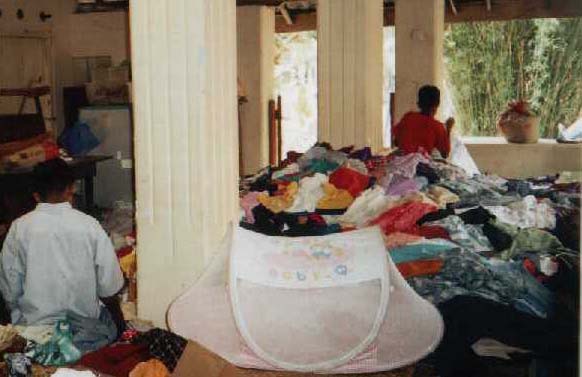 |
Yet after the devastating tsunami I went back to Unawatuna with my
brother on January 2, . He had visited Unawatuna a few days previously
and was returning with items requested by the monk at the Buddhist
Centre. Very basic items like bedding which had got washed away and
mops and brooms to clean the premises.
The Centre had been flooded to about 3 and 4 feet during the first and second waves and the level was clearly watermarked on the wall. They were getting the place organized. The books that had not got washed away had been put out to dry. They welcomed the brooms and started cleaning. A lot of clothes were being sorted and stacked in the meditation hall ready for distribution to the tsunami victims. |
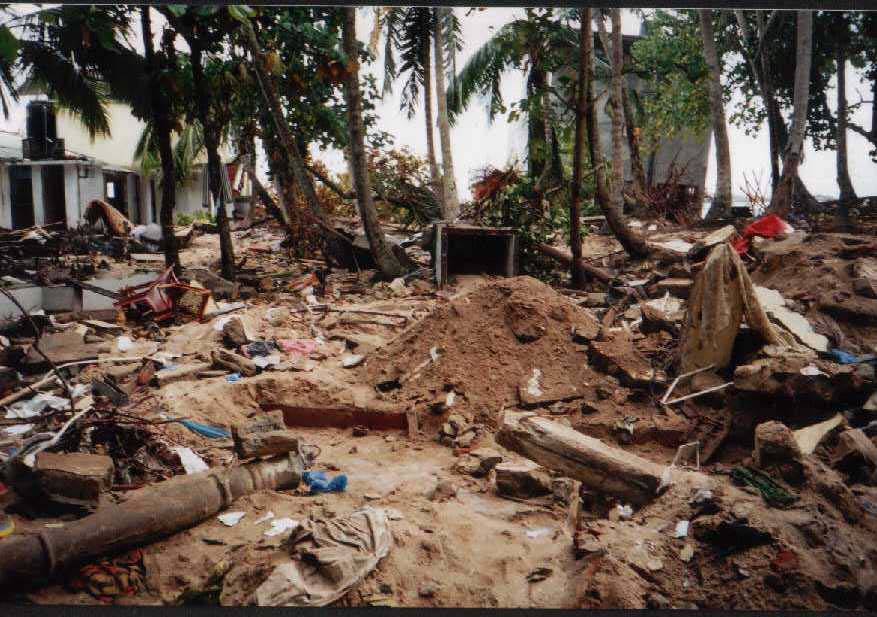
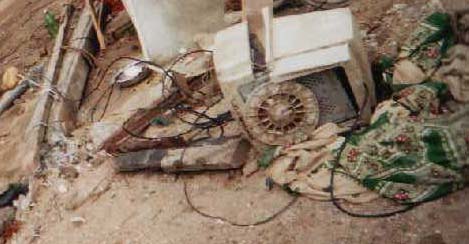 | At the beach, it was a scene of utter devastation. The tsunami had churned everyone's belonging with their broken houses and furniture and left a big mess. Computer monitors from the Internet cafe lay half buried in the sand. The sea had eroded about 30 feet of the beach. The first row of illegal beach huts had been washed away. The hotels on the landside of the road were now facing the sea. Although most had been damaged, the owners probably consider it a blessing in disguise since this rare tsunami had improved their location on the bay. |
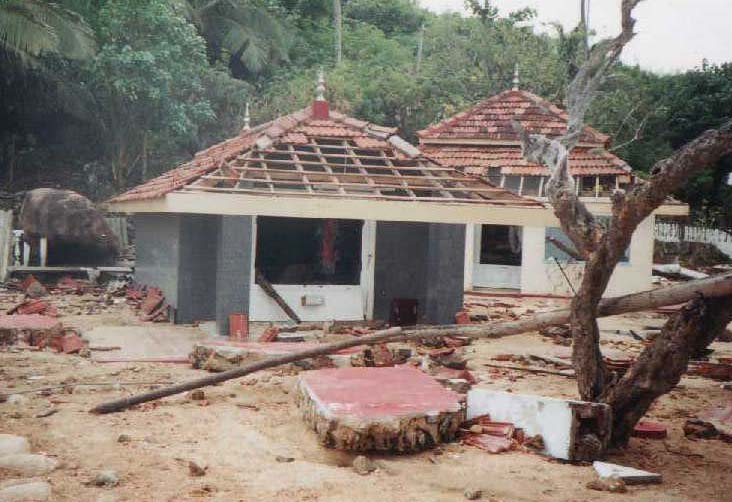
The beach erosion had made the stream that entered the sea near the Devale much deeper and broader. I remember wading through it the last time I had visited. This time we had to cross by walking on a coconut tree trunk that had been placed over it as a bridge further up the stream. The Devale had been badly damaged but not destroyed. The walls aroud the Devale which used to hold the oil lamps had fallen as large slabs. Looking at the dislocation of tiles on the roof one realized that water must have reached almost to the top of the roof. The Buddha statue in the building behind was intact.
We walked up the steps behind the Devale to the Vihara on top of the rock. It was safely above any damage. We now had an overview of the bay. Most of it was back to nature. I hope the government coastal protection agency will strictly impose the 100-metre rule in Unawatuna bay, and the few remaining hotels visible from this spot will agree to rebuild further back and be invisible behind the coconut trees. Unawatuna would then regain its majestic beauty, as the beach slowly rebuilds.
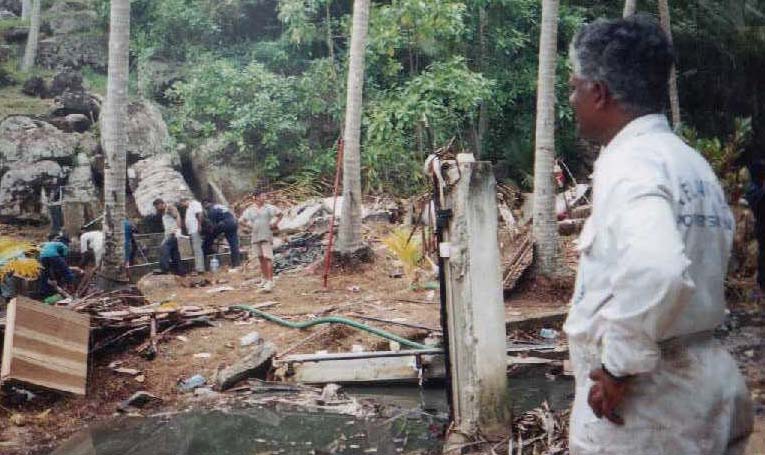
At the Vihara we met an engineer who had come to Unawatuna with some water pumps from a power station. He was helping with a group of volunteers to clean the drinking water wells of sea water. Not seeking any publicity, just systematically getting the urgent job done.
Watuna in Sinhala translates to fallen. Hanuman the monkey god of the great Indian epic the Ramayana brought back a whole mountain from the Himalayas when he could not remember the herb he had been asked to fetch for Lakshman. Legend states that part of that mountain broke off and made Unawatuna. Unawatuna has clearly fallen from beauty before the tsunami, and now lies in shambles after it.
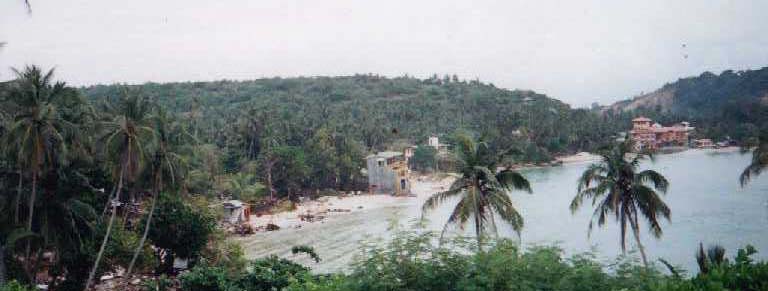
We can only hope that when it is rebuilt, the tourist industry will understand what to leave to nature so that everyone can enjoy again the beauty of Unawatuna bay with only the Devale visible from it.
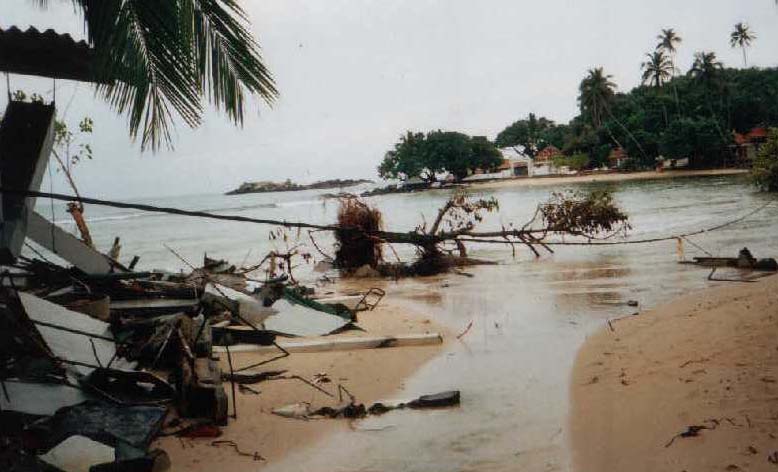
See also my article Lost to Sea on my trip on 2004 Dec 31st to Arugambay in south east Lanka.
Unawatuna images via google.